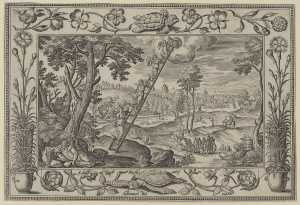Author: Albert Elen
Hans Bol, born ‘of good descent’, two paternal uncles being painters, was trained in the Malines tradition of ‘water-verwers’ (water-painter) or ‘doekschilders’ (canvas painters). These pictures, painted with watercolour or tempera on canvas, were used as wall decorations and formed a more affordable alternative to the very expensive tapestries.1 Little of this mass production remains. Despite his success in this typical Mechelen specialty, frustrated because his designs were widely copied and even sold under his name, Bol abandoned it and chose to work with very small sizes, more difficult to be copied by others, devoting himself to drawings minutely finished in colours on parchment. In addition to these miniature-like gouaches, Bol is known for his extensive graphic oeuvre of both uncoloured drawings and prints. His earliest known drawing, signed and dated 1557, is in the collection of Museum Boijmans Van Beuningen (inv. no. N 35).
According to his compatriot, fellow artist and biographer Karel van Mander (Schilderboeck, 1604), Bol was apprenticed for two years to an ordinary local canvas painter when he was 14 years old.2 After that he travelled in Germany, first staying in Heidelberg for two years, eventually returning to his native city of Malines in 1560. There he was enrolled in the painters guild in 1560 or 1561. Bol settled in Antwerp in 1572 after Malines had been taken and plundered by Spanish troops trying to regain control in the low countries after the waves of revolt and iconoclasm. He joined the Antwerp guild of St Luke in 1574, together with his younger brother Jacob (or Jacques) and received citizenship a year later. When the city on the river Schelde also came under siege, surrendering the year after, he was one of the many artists from the Southern Netherlands who fled the Spanish oppression and sought their fortune in the free province of Holland. In 1584 Bol travelled to the North, following his brother Jacob, who went to Dordrecht in 1578. By way of Bergen op Zoom (where he had been before, around 1579-80), Dordrecht and Delft, he finally arrived in Amsterdam around 1588, and died there in 1593.
Bol became an important link between the Flemish landscape tradition and that of the Northern Netherlands. His drawings bare witness to the prominent role he played in the development of landscape art in the Netherlands.3 His landscapes are often populated by human figures, in scenes from the bible or from everyday life, often combined. Realistically observed details mingle with elements drawn from the imagination. In this approach to landscape Bol was influenced by the work of his contemporary Pieter Bruegel the Elder. With this great master he also shared his preference for depicting the seasons and the months of the year. Bruegel had revived this medieval tradition with his monumental series of the months, painted in 1565. In the following years he made designs for a series of prints of the Four Seasons. When Bruegel passed away in 1569, only Spring and Summer had been completed. That Bol was approached by the famous print publisher Hieronymus Cock to make designs for Autumn and Winter, demonstrates the high esteem the artist already enjoyed by 1570. In effect, through this commission the young Bol became the old Bruegel’s successor. In the following years Bol designed several more series of the Four Seasons with the activities characteristic of each. None of these is as exhaustive as the series of the Twelve Months in Museum Boijmans Van Beuningen (inv. no. MB 2005/T 2), which was engraved by Adriaen Collaert to the order of the print publisher Hans van Luyck, and thus became widely known and exerted great influence on contemporary artists. A year later. In 1582 Hans Bol and his workshop illuminated the Book of Hours of the Duke of Alençon, who was proclaimed Duke of Brabant in that year.4
Among his pupils recorded in 1572, 1575 and 1580 were his stepson Frans Boels and Jacques Savery (c. 1565-1603), the latter mentioned by Carel van Mander as his best pupil. Gillis van Coninxloo, Joris Hoefnagel and David Vinckboons are also considered to have been trained by him. Bol was portrayed by Hendrick Goltzius in his engraving of 1593, the year he died of the plague, just as Savery did.
Footnotes
1 Miedema 1981, p. 181.
2 Van Mander 1604, fols 260r+v (ed. Miedema 1994, vol. 1, pp. 298-301, vol. 4, commentary, pp. 208-218).
3 Franz 1965, passim.
4 Paris, Bibliothèque Nationale de France, inv. no. Lat. 10564; Boon 1992, vol. 1, pp. 37-38.



















